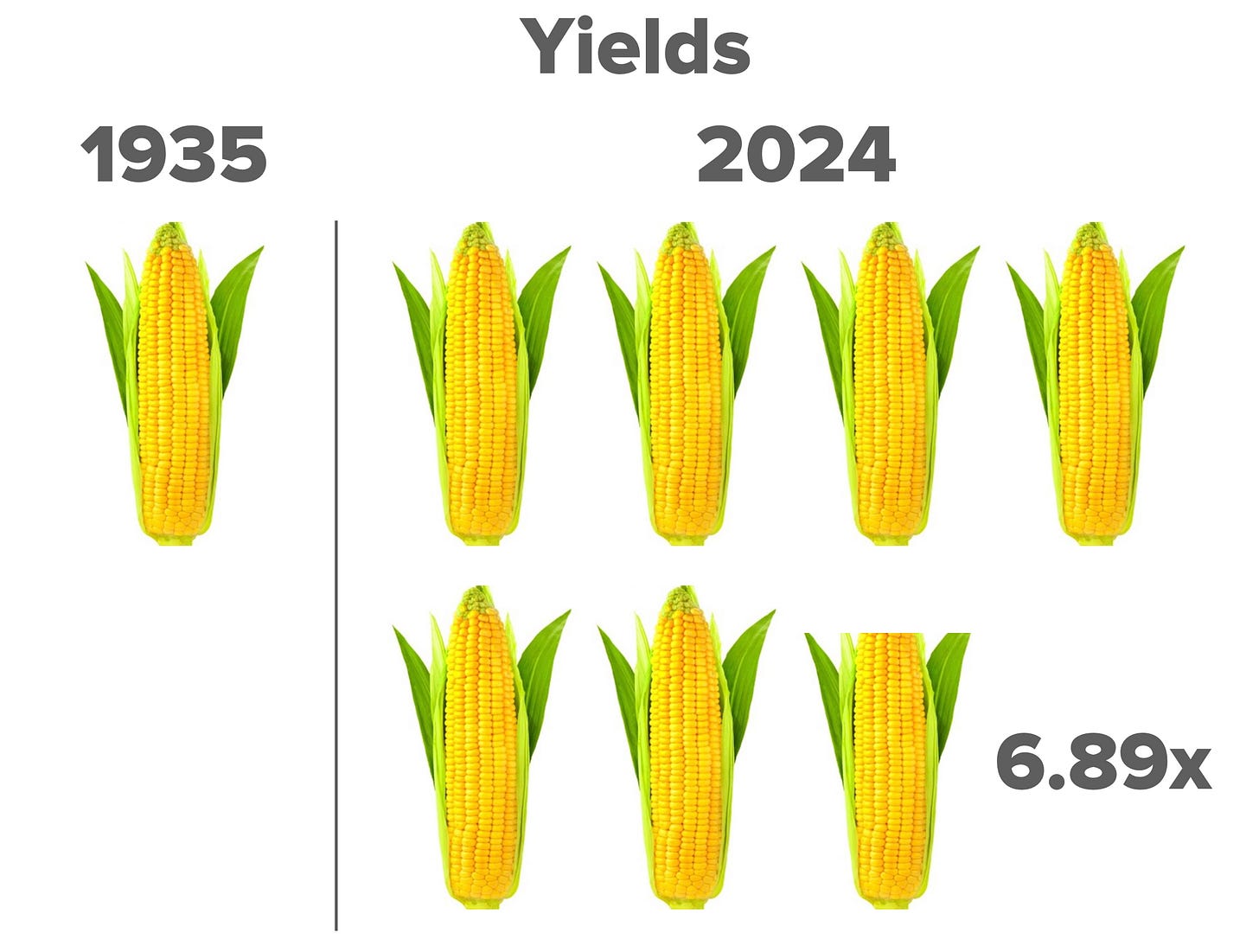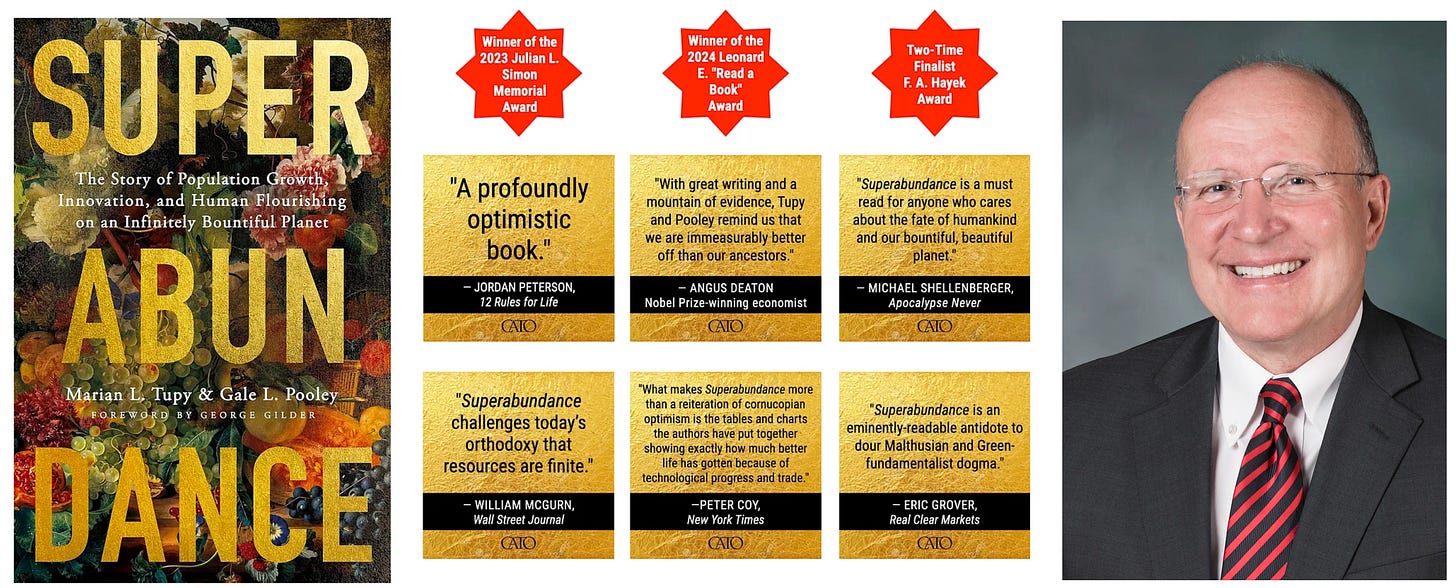Cornpreneurs Save Us From Davos Elites
Since 1936 U.S. population increased by 165.6 percent while corn yields increased by 589.6 percent. Corn yields are increasing 3.56 times faster than population. Who's going to tell Thanos?
Corn has a rich history stretching back thousands of years to Mesoamerica, where it was domesticated from a wild grass called teosinte. Indigenous peoples in the Americas developed corn through selective breeding, making it a cornerstone of their diets, cultures, and civilizations. After Christopher Columbus introduced corn to Europe in 1493, it spread rapidly across the globe, becoming a dietary staple and key ingredient in countless cuisines.
Today, corn is the most widely produced grain in the world, with global production exceeding 1.2 billion metric tons. The United States leads the world in corn production, consumption, and exports—accounting for 31 percent of global output with 377.63 million metric tons, according to the USDA.
Over 95 percent of animal feed for livestock like cattle, hogs, and poultry in the U.S. comes from corn, which makes up roughly 40 percent of all corn used domestically. Despite this abundance, the Davos crowd would have us believe that our survival hinges on swapping steaks and burgers for worms and insects. Under the banner of “sustainability,” they propose shuttering our Texas Roadhouses, Dickey's Barbecue Pits, and Chick-fil-A’s to make way for bug burgers. But are we really running out of beef, chicken, and pork?
Hardly. Corn is a foundational feed for producing those delicious meats. In the 1930s, U.S. corn yields averaged 26 bushels per acre. Today, that number is 179.3—with top-performing farms reaching an astonishing 624 bushels. That’s a 589.6 percent increase in yield over 88 years. One acre today produces as much corn as nearly 6.89 acres did in 1936, freeing up 5.89 acres for other uses—from conservation to recreation. Yields continue to rise at about 1.75 bushels per year, doubling every 31.6 years thanks to a 2.21 percent annual growth rate.
Meanwhile, the U.S. population grew 165.6 percent between 1936 and 2024—from 128 million to 340 million. Yet every 1 percent increase in population has corresponded with a 3.56 percent increase in corn abundance. In 1936, feeding one bushel of corn per person would’ve required 4.9 million acres. Today, even with 212 million more people, it would only take about 1.9 million acres. We’ve reduced land needs by 61 percent. We’re growing smarter much faster than we’re growing people.
Corn was selling for around 68 cents a bushel in the 1930s. Unskilled workers were earning around 28 cents an hour. This would put the time price at 2.42 hours. The USDA currently estimates the season-average corn price at $4.20 per bushel for the 2025-2026 crop year. Unskilled worked are earning $17.17 an hour putting the time price at 0.24 hours or around 15 minutes. The time price has fallen from 145 minutes to 15 minutes, or almost 90 percent. For the time it took an unskilled worker to earn the money to buy one bushel of corn in the 1930, they get 9.7 bushels today.
MIT’s Andrew McAfee highlighted this trend in More from Less, predicting continued innovation in agriculture. He’s even backing his confidence with a $100,000 bet: that by 2029, the U.S. will produce more crops than in 2019 while using less land, fertilizer, and irrigation. If you think he’s wrong—and believe the WEF's bug-eating future is inevitable—there’s your chance at easy money.
So yes, you could try a worm with your next meal—but there’s no reason to think we’re running out of corn or the land to raise your next steak, wing, or chop.
Bonus question: Are bug burgers vegan certified? Yes or No.
This is an update and Restack from a classic Gale Winds article.
Learn more about our infinitely bountiful planet at superabundance.com. We explain and give hundreds of examples why more people with freedom means much more resource abundances for everyone in our book, Superabundance, available at Amazon.
Gale Pooley is a Senior Fellow at the Discovery Institute, an Adjunct Scholar at the Cato Institute, and a board member at Human Progress.
You can now book Gale to speak about Superabundance and the new economics of human flourishing to your organization at All American Speakers.









